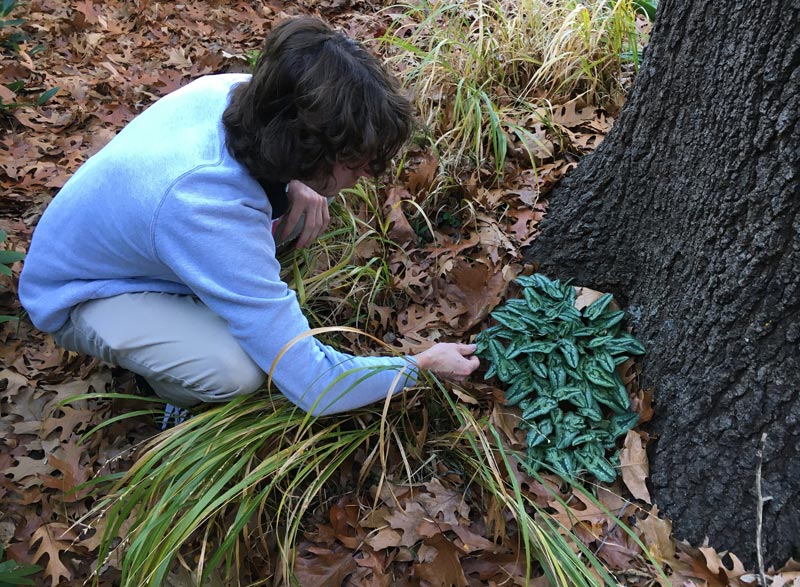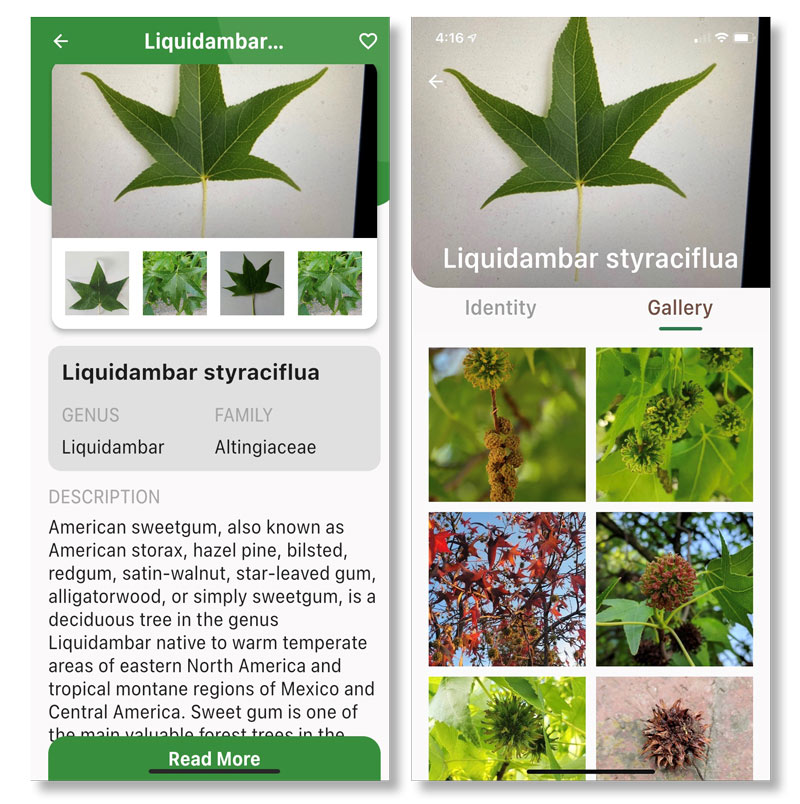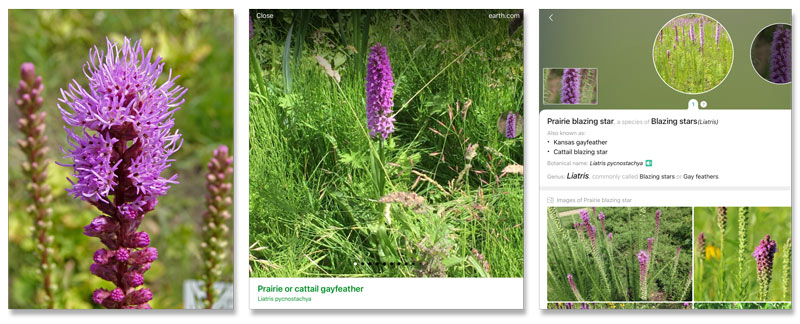
When identifying plants other than turfgrass becomes a challenge, superintendents can look to a number of smartphone apps that can swiftly supply more than just a name, boosting one’s course expertise and overall horticulture IQ. Photo by Garry McDonald, University of Arkansas
Golf course superintendents may often be viewed primarily as “grass farmers,” but the reality is that the golf course maintenance staff has to manage much more than just the greens and other playing surfaces. It is responsible for trees on the course, shrubs around the clubhouse, ornamental beds around the tees, native plantings outside the managed turf, potted plants in and around the clubhouse, and even vegetable gardens for the club kitchen staff. In addition to all the plants on the course, superintendents have to manage habitats that support birds, fish, pollinators, insects and various types of mammals and reptiles.
Ultimately, a golf course management team must be a group of extreme naturalists in order to properly manage and protect all of these important features of the course.
A self-taught horticulturist
Most university turfgrass management programs are found in horticulture, agronomy (crops and soils) or plant science departments. Depending on the school, students who go through these programs may get additional training in the broad science of horticulture, or they may take more electives in crop physiology or corn production.
Even though I, Mike Richardson, have been a faculty member in a horticulture department at the University of Arkansas for over 20 years, my personal path to turfgrass science went through agronomy departments. My academic training did not include a single horticulture class, but I can still discuss the nuances of producing irrigated rice. So, when someone asks this horticulture professor a horticulture question that’s outside of the turfgrass arena, I am often like the proverbial deer in the headlights.
I have been fortunate to learn a little about horticulture over the past couple of decades, but there is still much more to learn, and I am not sure I will ever be comfortable calling myself a horticulturalist. The good news is that there are lots of resources out there that can help you work your way through some horticultural questions and allow you to be, like me, a self-taught horticulturalist.
Easy plant ID: LeafSnap
When we first started including smartphone apps in our “Gadgets and Gizmos” class at the Golf Industry Show, one of the first cool apps we came across was LeafSnap. The idea for this app was hatched by a team of computer scientists and students at Columbia University who were working on face-recognition software.
If you have a relatively new smartphone, you are very familiar with face-recognition technology that will open your phone without you having to enter a passcode (more recently, you may have noticed the feature is useless when you’re wearing a mask!). Those developers also realized the software could be useful in identifying other things, including plant species. The scientists at Columbia engaged other researchers at the University of Maryland and the Smithsonian Institution and began to develop an app that could be used to identify trees, primarily in the northeastern United States and Canada.

Figure 1. Using a photo of a tree leaf taken by a smartphone, the LeafSnap app analyzes the shape of the leaf and identifies the tree’s family, genus and species.
The basic premise behind LeafSnap is that the camera on your smartphone takes a picture of a tree leaf against a white background, such as a piece of paper, and the app then does a shape analysis on that picture to narrow down the tree choices to the most likely two or three options. The user can then look more closely at high-resolution images of the leaves, buds, bark, flowers or fruit of the primary choices and make a final determination of the species (Figure 1).
Once the species has been determined, the app provides lots of valuable information about the species, such as size, preferred habitat, etc. Although the most extensive database remains for the trees of North America, the app has been expanding to other parts of the world. I have used the app to correctly identify trees in various parts of Europe and Australia.
More smartphone apps for plant identification
As with most technologies, what is very cool one day can often become very common by the next. Since the introduction of LeafSnap about 10 years ago, a whole suite of apps has appeared that can identify plant species, insects, fish and a host of other critters you may find on your golf course. While we won’t cover all of them in detail, most of them work on the same premise as LeafSnap in that shape analysis is used to reconstruct the image. Here are some brief summaries of the plant-identification apps we find most interesting.
PlantSnap
PlantSnap boasts a database of more than 650,000 plants and 475 million-plus images. Not only does PlantSnap employ shape analysis and artificial intelligence to quickly identify the plant of interest, but it also continues to build knowledge based on every piece of new data obtained through users. To my knowledge, PlantSnap is also the only plant-identification app that interacts with social medial platforms (in this case, Snapchat) to enhance the user experience and engage other users.
Editor’s note: Apps can assist with more than plant identification. Discover handy digital tools that make quick work of determining the area of the variously shaped spaces around your golf course in What the Tech? Easy ways to measure turfgrass area.
PictureThis
PictureThis (App Store, Google Play) uses recognition software and artificial intelligence to get smarter. The app claims to be able to identify over 1 million plants and adds new information daily based on user inputs. The subscription service for this app also provides access to live experts who can help identify a plant or provide additional information about the plant and its uses. Various price packages from $1.99 up to $49.99 are available depending on how much you plan to use the app and any additional services you may want, such as access to live experts.

Figure 2. Identification of a plant from a photo of the flower. In this case, the plant was identified correctly by both PlantSnap and PictureThis as prairie blazing star (Liatris pycnostachya).
PlantNet
PlantNet is a well-organized plant-identification app that collects data on plants and arranges plants by regions (for example, Australia) or themes (rainforest). The other thing I see discussed with this app is that data collected by “citizen scientists” may be used in the future by real scientists to track and study the presence of certain species. This could provide valuable information to the scientific community and the general public.
Although these plant-identification apps are really useful when it comes to identifying trees or herbaceous plants, I am not aware of an app that can accurately identify grasses using shape analysis, especially mowed turfgrasses. This is primarily because the identifying features of grasses are very subtle and would be difficult for the camera to capture. I guess that will keep turfgrass professors in business for a few more years.
We did a simple demonstration of a couple of these apps using a photo of a prairie blazing star (Liatris pycnostachya), a common forb found in tallgrass prairies (Figure 2, above). In this case, both PlantSnap and PictureThis correctly identified the plant of interest, and both apps also provided additional images and information about the plant identified.
Identification apps: Beyond plants
There are a number of new apps out there that get out of the world of plants and focus on the identification of insects, mushrooms, birds and more. Some of these apps use recognition software, while others require user inputs to narrow searches (this is necessary with birds, for example, because they may not cooperate when it comes to posing for a photo).
Finally, one website that I have also found to be interesting and useful is NatureGate. Users identify plants, animals, birds, fish, butterflies, etc., by entering characteristics of the critter in question; the website narrows the list of possibilities as more characteristics are entered.
There is little doubt these types of services and apps will continue to evolve in the years ahead and can become a more integral part of our daily activities. I would encourage those in golf course maintenance to play around with these apps and make specific comments to the developers about what would be useful to you. I could also see the information gathered from these apps being useful when writing columns for your club newsletter or providing content to your local newspaper. Remember: Golf course superintendents are some of the greatest master naturalists out there.
Mike Richardson is a professor, Doug Karcher is a turfgrass soil specialist and professor, and Daniel O’Brien is a former program technician in the Department of Horticulture at the University of Arkansas in Fayetteville, Ark.